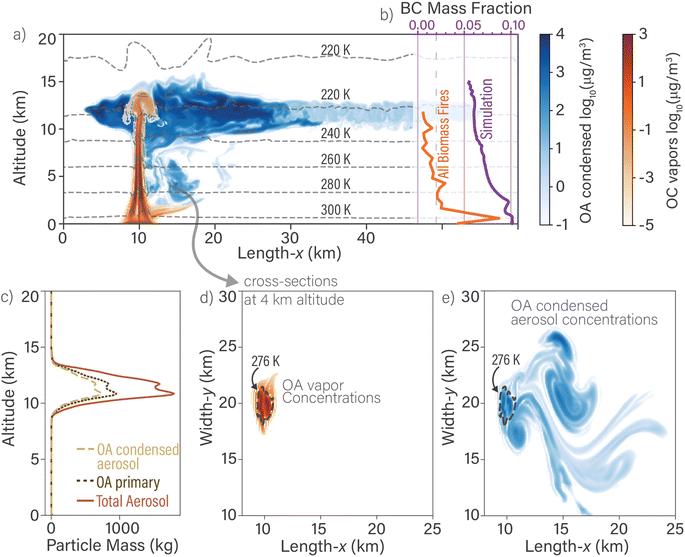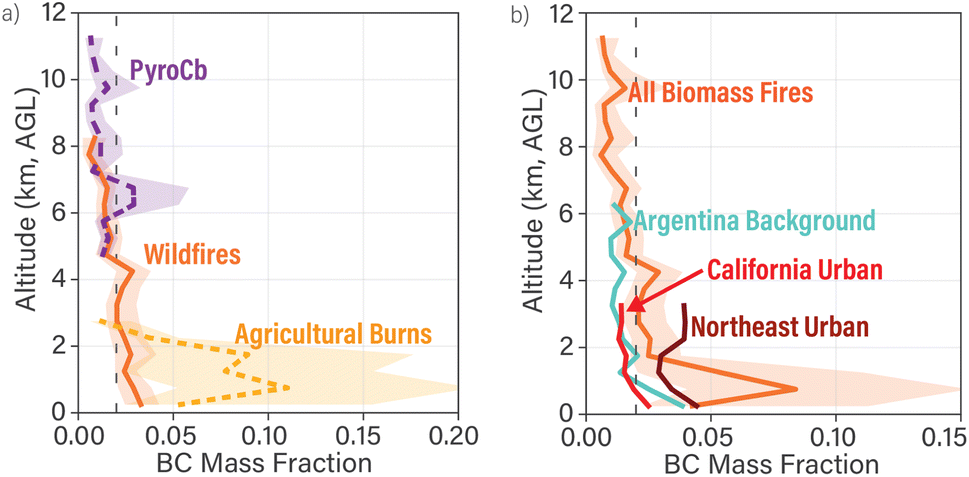Vapor condensation in pyrocumulus smoke raises organic aerosol and lowers black carbon fraction
Submitter
Dubey, Manvendra K.
— Los Alamos National Laboratory
Gorkowski, Kyle — Los Alamos National Laboratory
Area of Research
Aerosol Processes
Journal Reference
Gorkowski K, E Koo, S Jordan, J Reisner, K Benedict, and M Dubey. 2024. "Insights into Pyrocumulus aerosol composition: black carbon content and organic vapor condensation." Environmental Science: Atmospheres, 10.1039/D3EA00130J.
Science

Figure 2. LES simulation at 12.5 hours with 3 m s−1 horizontal wind: condensed OA (blue) and organic vapors (orange). (a) Vertical cross-section with organic vapor gradients overlapped onto OA; temperature contours are dashed. (b) BC mass fraction profile in LES simulation (purple) compared to biomass burning observations (orange). (c) Plume profile after 12.5 hours, OA condensed aerosol from vapors (dashed gold), OA primary emissions non-volatile (dotted brown), and total aerosol mass. (d) Horizontal cross-section of organic vapor concentration with 276 K temperature contour. (e) Horizontal cross-section of OA condensed aerosol concentration from vapors, with 276 K contour. Image from journal.

Figure 1. (a) Altitude profiles of BC mass fraction (BC/PM1) for wildfire flights, identified fire plumes (orange), the single PyroCb plume (purple dashed), and agricultural fires (yellow). Medians with 25% and 75% percentiles shaded. BC mass fraction ranges 0.5–3% above planetary boundary layer (>3 km); thin gray dashed line at 2%. (b) Summary of altitude profiles of BC mass fraction from multiple campaigns including combined fire plumes (orange) and urban campaigns; Argentina summer background is from CACTI field campaign. Image from journal.
Megafires are increasingly generating pyrocumulus (PyroCu) clouds that loft particles high into the atmosphere to enhance their lifetime and climate forcing. Using aircraft-sampled data in these smoke plumes, we find that the mass fraction of black carbon (BC) is consistently between 0.5 and 3%. Additionally, we provide evidence of the volatile organic vapor condensing in the cold PyroCu updrafts that increases the aerosol mass. Simulations demonstrate organic vapor condensation can double the aerosol mass in updrafts.
Impact
We quantify the aerosol mass and black carbon content that pyrocumulus clouds inject into the stratosphere, a phenomenon exacerbated by the rise in megafires. These aerosols can persist in the stratosphere for 3 to 15 months, influencing the global climate. We find that the black carbon mass fraction within these clouds remains consistent and organic vapor condensation can double the aerosol mass, a critical constraint for climate models. The increasing frequency of megafires has intensified the climatic influence of pyrocumulus clouds, making our work crucial for accurately predicting their environmental impact. Our findings underscore the importance of considering both the vertical distribution of BC mass fraction in wildfire smoke plumes and the role of organic aerosol (OA) in shaping this fraction.
Summary
Megafires with climatic impact have occurred worldwide, injecting stratospheric aerosols that scatter sunlight, cooling the Earth's surface. These plumes can induce both immediate surface cooling (−3 °C) and prolonged global cooling. Given their slow removal (3–15 months from the lower stratosphere), PyroCu smoke plumes produce lasting radiative impacts, unlike their tropospheric counterparts, and are not treated in climate models. We probed the vertical distribution of BC mass fractions in wildfire smoke plumes and the influence of OA formed via condensation on modifying these fractions. We observed a consistently low BC mass fraction (0.5-3 %) -- in the free troposphere -- across different emission locations. This consistency may arise from OA formation, which curtails near-field variability as plumes disperse into the far field. Our chemical data and large-eddy simulations (LES) support vapor condensation in the cold plume updraft that can double the OA mass and reduce the BC mass fraction.
Keep up with the Atmospheric Observer
Updates on ARM news, events, and opportunities delivered to your inbox
ARM User Profile
ARM welcomes users from all institutions and nations. A free ARM user account is needed to access ARM data.


















